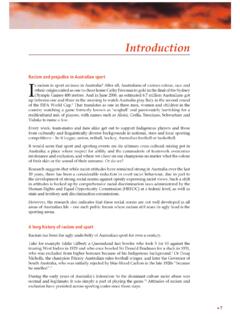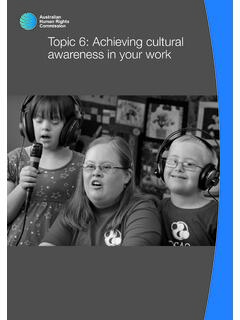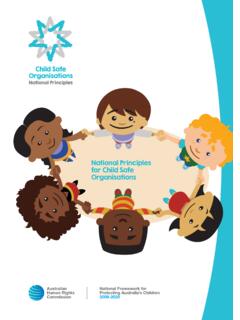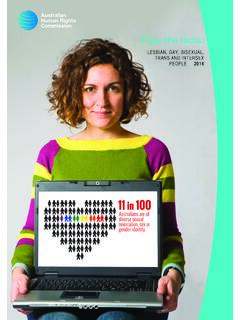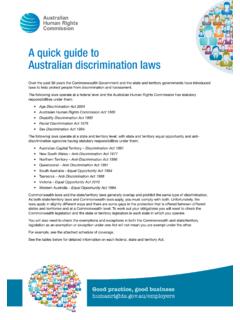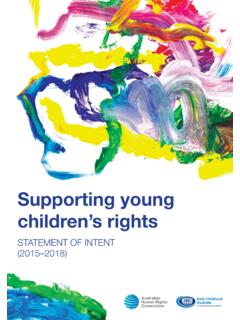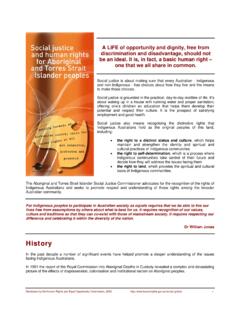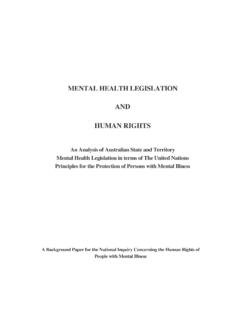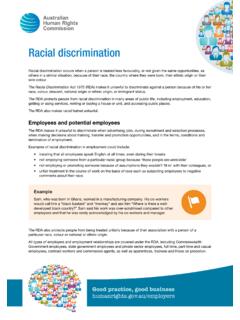Transcription of Building belonging - Australian Human Rights Commission
1 Building belongingA toolkit for early childhood educators on cultural diversity and responding to prejudiceEducator GuideBuilding belonging : A toolkit for early childhood educators on cultural diversity and responding to prejudice (2016)2 Australian Human Rights Commission Australian Human Rights Commission encourages the dissemination and exchange of information presented in this publication and endorses the use of the Australian Governments Open Access and Licensing Framework (AusGOAL).All material presented in this publication is licensed under the Creative Commons Attribution International Licence, with the exception of: photographs and images; the Commission s logo, any branding or trademarks; where otherwise view a copy of this licence, visit essence, you are free to copy, communicate and adapt the publication, as long as you attribute the Australian Human Rights Commission and abide by the other licence give attribution to: Australian Human Rights Commission Building belonging : A toolkit for early childhood educators on cultural diversity and responding to prejudice was developed by Annie Pettitt and Siobhan Tierney and produced in conjunction with Kimberlin Australian Human Rights Commission would like to thank the members of the Building belonging Reference Group for their contribution to the resources.
2 Naomi Priest ( Australian National University), Karen Hamilton-Chan (SDN Children s Services), Chris Steel (Early Childhood Australia), Meni Tsambouniaris (Ethnic Community Services Co-operative), Gulnara Abbasova (FECCA), Alex Shain (Reconciliation Australia), Adam Duncan (Reconciliation Australia), Megan Mitchell (National Children s Commissioner), Tim Soutphommasane (Race Discrimination Commissioner), Judy Radich (Cooloon Childcare), Mirjana Vukovic (ACCESS Settlement Services, Emma Sydenham (SNAICC), and Jacqueline Hayden (Macquarie University).The Australian Human Rights Commission would also like to thank the staff and children at SDN Linthorpe St and Goodstart Marrickville for testing the resources and providing publication can be found in electronic format on the Australian Human Rights Commission s website at further information about the Australian Human Rights Commission or copyright in this publication, please contact:Education and Innovation TeamAustralian Human Rights CommissionGPO Box 5218 SYDNEY NSW 2001 Telephone: (02) 9284 9600 Email: Creative Commons informationBuilding belonging .)
3 A toolkit for early childhood educators on cultural diversity and responding to prejudice (2016)3 ContentsIcon GuideAction/activity ideaViewing activityTools and strategiesQuestion/troubleshootingKey quotes/definitionsIntroductionWhy educate about cultural diversity and prejudice?How to use these resources in your early childhood settingEducating about cultural diversityChallenges in educating about cultural diversityEncouraging cultural competency in your early childhood settingCollaborating with families and communitiesUnderstanding and addressing prejudiceChildren s development self-awareness and prejudiceResponding to parental prejudiceConclusionLinks to educational frameworks and standardsThe Early Years Learning FrameworkThe Australian Curriculum (Foundation year level)The National Quality StandardThe Australian Professional Standards For Teachers (Proficient level)Additional resourcesReferences466778121415171920202 0212324284 IntroductionAustralia is a vibrant, multicultural country .
4 We are home to the world s oldest continuous cultures - aboriginal and torres Strait Islander cultures - as well as people who identify with more than 270 This cultural diversity is central to our national is important that young children in Australia today grow up with an appreciation and respect for the diversity of cultures, races and ethnicities that surround them. Early childhood education provides the ideal setting for children to learn about different cultures and form friendships with people from a wide range of promoting understanding of difference and diversity, early childhood educators can assist children and their families to build positive relationships with their local doing this, educators are fulfilling the requirements under the Early Years Learning Framework (EYLF) to cultivate respect for diversity and exercise cultural competency.
5 2 This Educator Guide serves as an introduction to the Building belonging toolkit of resources created by the Australian Human Rights Commission , which supports early childhood educators in teaching children about cultural diversity and addressing prejudice in early childhood settings. Diversity contributes to the richness of our society and provides a valid evidence base about ways of When early childhood educators respect the diversity of families and communities, and the aspirations they hold for children, they are able to foster children s motivation to learn and reinforce their sense of themselves as competent learners. The Early Years Learning Framework3 Building belonging : A toolkit for early childhood educators on cultural diversity and responding to prejudice (2016)5 The materials in the Building belonging toolkit include: The Building belonging Educator Guide Three lesson plans (linked to the Early Years Learning Framework and the Australian Curriculum), with accompanying lesson materials Three posters to display in your setting/staff room An educator information sheet on Responding to comments and questions about Cultural Diversity and Racial Identity All my friends and me e-book, which can be printed out, or displayed on a computer or smart device.
6 Colours of Australia song with accompanying action sheet, which can be played on a computer or downloaded and played using a portable music device. Discussing cultural diversity with your child information sheet for parents and carers A World of Flavours activity sheet for children to complete with their familiesThese resources can all be downloaded , blinking, ide and w winking, The brightest eyes I ve ever see colours, colours everywhere!The colours of Australia, the beauty we all spy with my little eyeBlue and brown and and noses, Fingers and toes,Healthy skin is all see colours, colours everywhere!The colours of Australia, the beauty we all see colours, colours everywhere!So let s hold hands and show we see colours, colours everywhere!
7 So let s hold hands and show we care. I spy with my little eyeBlonde and black and and ong,Curly and strong,Different hair on different spy with my little eyeWhite and tan and see colours, colours everywhere!The colours of Australia, the beauty we all see colours, colours everywhere!So let s hold hands and show we see colours, colours everywhere!So let s hold hands and show we care. I see colours, colours everywhere!The colours of Australia, the beauty we all re lucky to live in a colourful world, With lots of boys and lots of girls,We all look different but on the inside, We have the same heart and we wear it with pride!l Open, blinking, ide and wwinking, The brightest ey es I ve ever see colours, colours every where!The colours of A ustralia, the beauty we all spy with my little ey eBlue and brown and and noses, Fingers and toes,Healthy skin is all see colours, colours every where!
8 The colours of A ustralia, the beauty we all see colours, colours every where!So let s hold hands and show we see colours, colours every where!So let s hold hands and show we care. I spy with my little ey eBlonde and black and and ong,Curly and strong,Different hair on different spy with my little ey eWhite and tan and see colours, colours every where!The colours of A ustralia, the beauty we all see colours, colours every where!So let s hold hands and show we see colours, colours every where!So let s hold hands and show we care. I see colours, colours every where!The colours of A ustralia, the beauty we all re lucky to live in a colourful world, With lots of boy s and lots of girls,We all look different but on the inside, We have the same heart and we wear it with pride!
9 LColoursofAustraliaBuilding belonging : A toolkit for early childhood educators on cultural diversity and responding to prejudice (2016)6 Why educate about cultural diversity and prejudice?All children have a right to feel accepted and respected. This is a principle set out in the United Nations Convention on the Rights of the Child, the international Human Rights treaty on the Rights of The Convention emphasises the importance of children developing connections to culture and community as a means of fostering a strong sense of personal identity and This idea is reflected in the Early Years Learning Framework and the National Quality teaching respect for cultural diversity, educators will assist children to: learn about their cultural background and develop a strong sense of self identity learn about and appreciate cultures and traditions other than their own learn to enjoy and respect differences and recognise universal characteristics we all share learn about racial prejudice and understand why it should be challenged.
10 Culture is the fundamental Building block of identity and the development of a strong cultural identity is essential to children s healthy sense of who they are and where they belong. Educators Guide to the Early Years Learning Framework for Australia7 How to use these resources in your early childhood settingThe Building belonging resources have been designed to cater to a range of settings, including preschools, kindergartens, long day care centres, family day care, and primary resources aim to support the existing work of early childhood educators around Australia to teach respect for cultural diversity and difference. It s recommended that the Building belonging resources be used to support existing policies, practices and programs. For a holistic approach, other resources - such as books and play materials illustrating and celebrating diversity and difference - should be incorporated into day-to-day activities.
